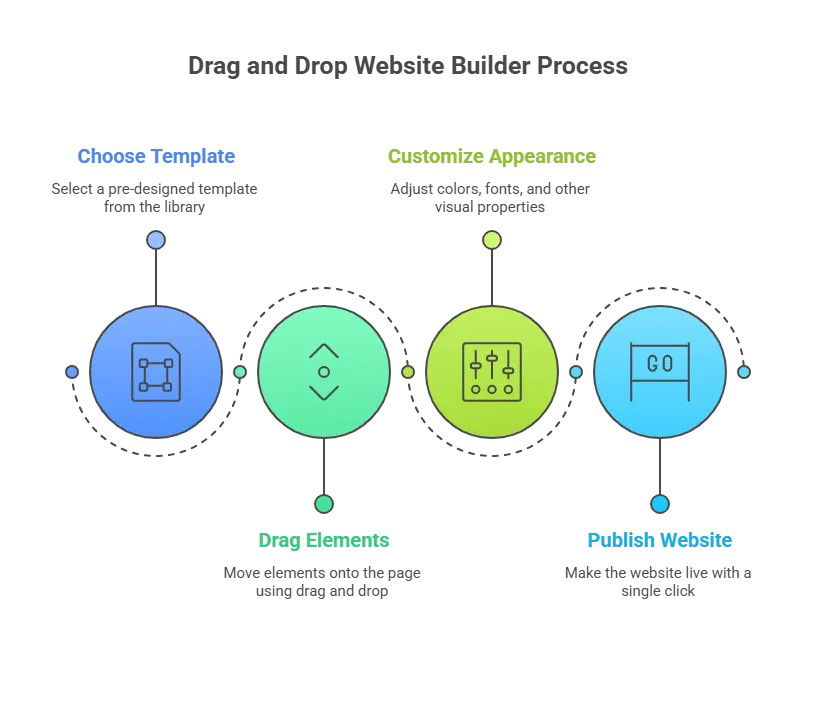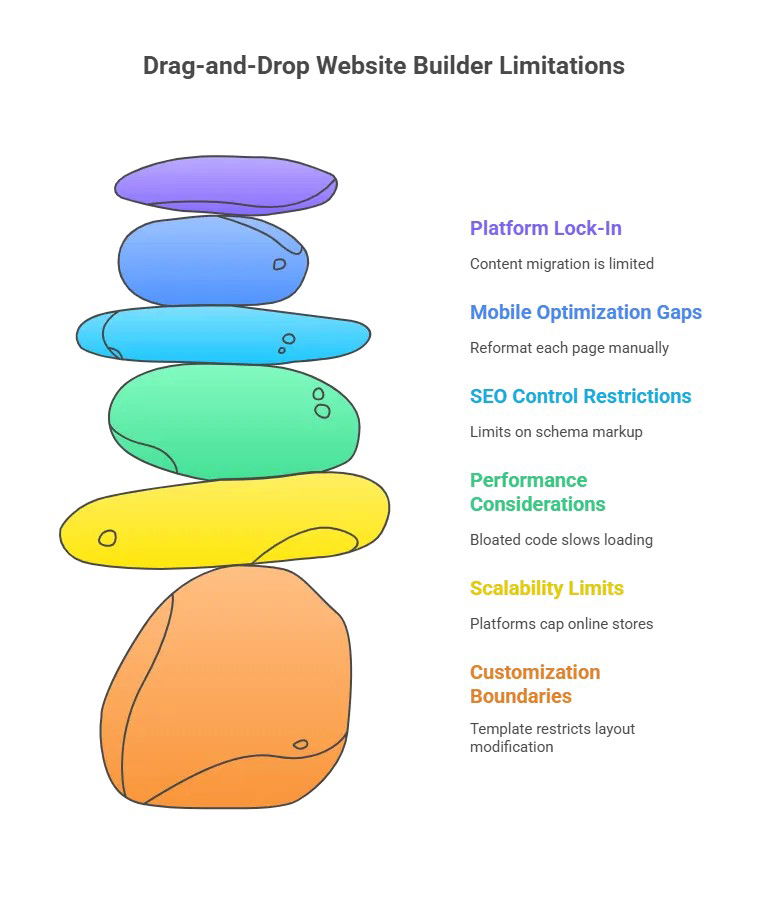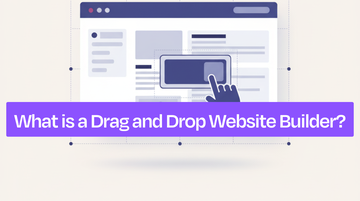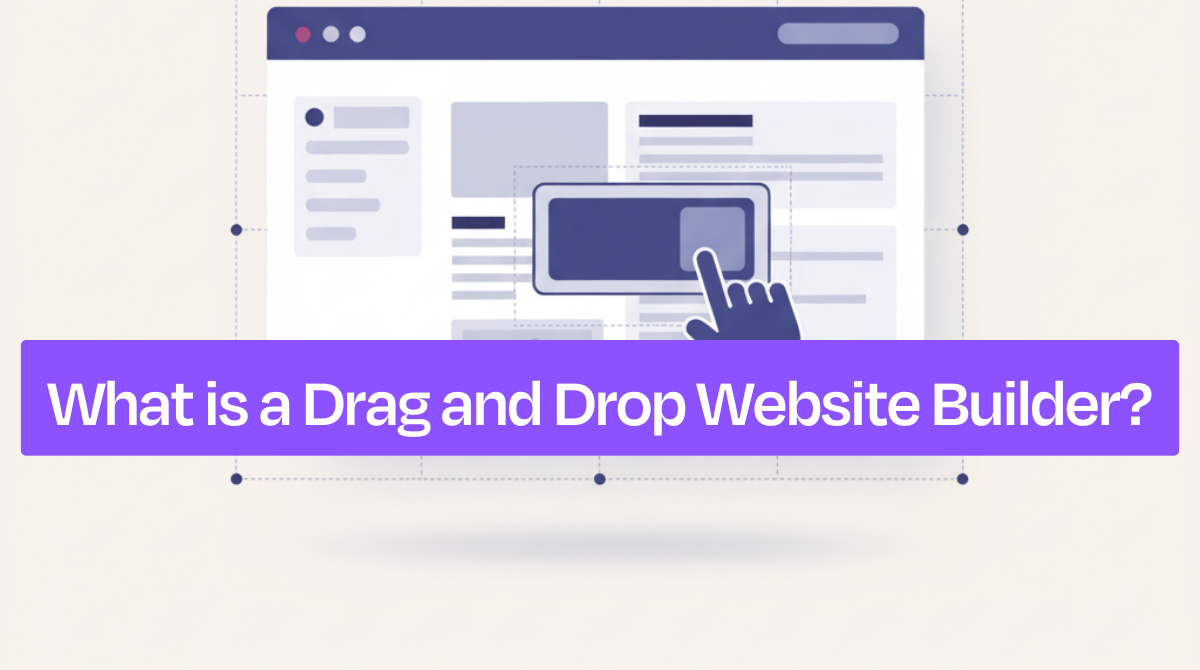A drag-and-drop website builder is a visual web design tool that lets you create websites by clicking, dragging, and placing elements like text, images, and buttons directly onto a canvas, no coding required.
These builders use WYSIWYG (what you see is what you get) interfaces where you select pre-designed templates, drag elements from a sidebar onto your page, customize colors and fonts through visual controls, and publish instantly.
Popular platforms like Dorik, Wix, and Squarespace enable anyone to build professional websites in hours, rather than months, eliminating the need for knowledge of HTML, CSS, or JavaScript.
How Does a Drag and Drop Website Builder Work?
A drag-and-drop website builder works through four steps,
-
Choose a template
-
Drag elements onto the page
-
Customize appearance using visual controls
-
Publish the website instantly.
Step 1: Choosing Your Starting Template
37% of businesses use templates with drag-and-drop builders to reduce design time from weeks to hours while maintaining professional layouts.
Most platforms categorize templates by industry, including e-commerce, hospitality, portfolios, consulting, restaurants, and photography.
Template libraries range from 100 to 1,200+ per platform: Dorik offers 110+ templates, Wix provides 1,200+, and Squarespace includes 195 options across 20+ industries, including restaurants, portfolios, agencies, and retail stores.
Each template includes pre-built navigation menus, color palettes, hero sections, galleries, contact forms, and footer layouts ready for customization.
Templates reduce launch time from 40+ hours to 2-4 hours by providing pre-designed page structures where users swap text, images, and colors rather than building layouts from scratch.
Step 2: Dragging and Dropping Elements
The core action of a drag-and-drop builder follows a click–hold–move–release mechanic. Users select an element from the side panel, hold it with the cursor, drag it to the desired location on the page, and release it to place.
Common draggable elements include text boxes, image galleries, buttons, contact forms, icons, and embedded videos. As you move items, the visual editor provides alignment grids, snapping guides, and spacing indicators to maintain balance and consistency across the layout.
Each dropped element instantly appears in the WYSIWYG preview, allowing real-time feedback on design adjustments.
Users see placement results instantly in the editor without switching to preview mode, eliminating the edit-save-preview cycle required in traditional development.
Understanding Structured Editors
Structured editors operate on a grid-based system where every element snaps into predefined rows or columns. Platforms like Squarespace Fluid Engine, and Hostinger Website Builder use this approach to maintain clean alignment and automatic mobile responsiveness.
Users can rearrange blocks within the grid, but cannot freely overlap or place them outside the boundaries.
This structure automatically adjusts element spacing and sizing for mobile devices, eliminating manual responsive design work but restricting pixel-perfect placement options.
Understanding Unstructured Editors
Unstructured editors allow pixel-perfect placement, giving users total control over where each element appears. Platforms such as Wix and Canva Websites let users drag items anywhere on the page, overlap layers, or build asymmetrical designs for a unique aesthetic.
The trade-off is that mobile layouts require separate adjustment, since elements don’t automatically resize or realign.
This editor type allows overlapping elements, asymmetrical designs, and custom spacing, but requires separate mobile layout adjustments for screens under 768 pixels wide.
| Feature | Structured Editor | Unstructured Editor |
|---|---|---|
| Freedom | Elements snap to a 12-column grid; cannot overlap or position outside grid boundaries | Elements position anywhere on canvas; supports overlapping layers and absolute pixel positioning |
| Mobile Optimization | Automatically responsive across all devices | Requires manual adjustment for mobile layouts |
| Learning Curve | 30-60 minutes to learn; guided structure prevents layout mistakes | 1-2 hours to learn; requires understanding of visual hierarchy and spacing principles |
| Best For | Business sites, portfolios, and service pages need consistency | Creative projects, marketing pages, and custom designs |
| Examples | Squarespace Fluid Engine, Hostinger Website Builder | Wix, Canva Websites |
Step 3: Customizing Element Properties
Once elements are placed, visual control panels adjust colors, fonts, sizes, spacing, borders, and backgrounds without CSS. Users can modify colors, fonts, sizes, spacing, borders, and backgrounds without writing a single line of CSS.
Each adjustment appears instantly in the preview (known as “WYSIWYG” or “what you see is what you get”), enabling users to test multiple color schemes, font pairings, and layouts in minutes.
Advanced builders include animations (fade, slide, zoom), hover effects (color changes, underlines, shadows), and transparency settings (0-100% opacity control).
Visual editing enables testing 5-10 design variations in 10-15 minutes without code changes.
Step 4: Publishing Your Website
After customization, users preview their website across desktop (1920px+), tablet (768-1024px), and mobile (320-767px) views to verify element positioning and text readability. A single 'Publish' click makes the site live instantly.
Most drag-and-drop builders include automatic hosting, Let's Encrypt SSL certificates, and one-click domain connection within the platform interface.

Key Benefits of Drag and Drop Website Builders
Key benefits of drag-and-drop website builders include eliminating the complexity of code, reducing launch time from months to hours, and providing scalable features as businesses expand.
No Coding Knowledge Required
Drag-and-drop builders eliminate HTML, CSS, and JavaScript requirements by providing visual controls for typography (15+ font families), colors (hex, RGB, HSL), spacing (padding, margins), and layout positioning (flexbox, grid).
Non-technical users, such as entrepreneurs, freelancers, teachers, and small business owners, can modify site content, update images, and adjust layouts without developer assistance.
Faster Website Launch
Traditional website projects require 2-6 months: 2-4 weeks for discovery and wireframes, 3-6 weeks for design mockups, 4-8 weeks for development, and 1-2 weeks for testing.
Drag-and-drop builders reduce that to even within 30 minutes to a few hours for simple sites or one to four weeks for larger projects.
Browser-based editing with instant preview and one-click publishing enables same-day launches for landing pages and 1-week launches for 5-10 page websites.
Cost-Effective Solution
Drag-and-drop builders provide free plans and affordable upgrades that range from $10 to $50 per month, far below the $2,000 to $10,000 usual cost required for custom-coded websites.
Website builders like Dorik, Wix, Squarespace, and Hostinger bundle hosting, domain connections, and SSL certificates in subscription plans.
This pricing model eliminates $500-2,000 annual maintenance costs for security updates, plugin management, and hosting optimization.
Professional Templates Included
Most builders include 100-900 industry-specific templates with automatic mobile responsiveness and 2-3 second load times on 4G connections.
Templates include pre-built sections for hero banners, product galleries, testimonial displays, pricing tables, contact forms, and newsletter signups.
Users customize template colors, fonts, images, and content through visual controls without modifying underlying code.
Real-Time Design Preview
Drag-and-drop builders use WYSIWYG interfaces where the editor view matches the published website exactly, including layout, colors, fonts, and spacing.
This means the page displayed in the editor mirrors exactly what visitors will see when the site goes live.
Users can preview their designs instantly across devices, which ensures consistent formatting on desktop, tablet, and mobile.
Real-time preview eliminates the edit-upload-review cycle, reducing design iteration time from hours to minutes.
Maintenance and Updates Handled
Drag-and-drop platforms manage hosting uptime (99.9%+ availability), automatic security patches, SSL certificate renewals, and CDN updates.
Users don’t need to install plugins, patch vulnerabilities, or troubleshoot downtime.
This hands-off model eliminates 2-5 hours of weekly technical maintenance, freeing business owners to create content, manage marketing campaigns, and respond to customers.
Scalable as Business Grows
Business plan upgrades unlock advanced analytics (conversion tracking, user behavior heatmaps), 500+ app integrations (payment processors, email marketing, CRM), and eCommerce capabilities (inventory management, abandoned cart recovery) without site migration.
Dorik's AI website builder generates complete landing pages with hero sections, feature grids, testimonials, and CTAs from 1-2 sentence prompts in 30-60 seconds.
Integrated SEO Tools
Dorik, Wix, Squarespace, and Hostinger include built-in SEO tools for setting meta titles (50-60 characters), descriptions (150-160 characters), and URL slugs directly from the visual editor.
These platforms generate XML sitemaps automatically and provide alt text fields for images, helping search engines index content and display images in Google Image Search results.
Built-in SEO tools eliminate the need for 5-10 separate SEO plugins required in WordPress for equivalent functionality.

Limitations to Consider
Drag-and-drop builders impose technical constraints, including 500-5,000 product limits, restricted Schema markup access, bloated HTML/CSS output, and platform-specific export formats.

Customization Boundaries
Drag-and-drop builders restrict users to template-defined page structures, preventing custom HTML/CSS modifications unless the platform offers code injection features.
Visual controls adjust colors, fonts, and spacing, but database integrations, custom animations, and API connections require developer intervention or third-party scripts.
Template constraints prevent implementing custom checkout flows, unique navigation patterns, or interactive data visualizations without custom development.
Scalability Limits
Dorik, Wix, and Squarespace support small to mid-sized businesses but impose limits at higher traffic and product volumes.
Wix limits stores to 500 products on basic plans, Squarespace caps at 10,000 items on commerce plans, and most platforms restrict API calls to 100-1,000 requests per hour.
Stores exceeding product limits experience 3-5 second page load increases and cannot access bulk inventory management or multi-currency checkout.
Businesses requiring 10,000+ products, multi-warehouse inventory, or custom pricing logic migrate to Shopify Plus, BigCommerce, or custom-coded platforms.
Performance Considerations
Drag-and-drop systems generate HTML and CSS with 30-50% more code than hand-written websites due to visual layer abstractions.
This excess code increases page sizes from 500KB to 800KB+ and adds 1-2 seconds to load times on 3G connections.
Load times above 3 seconds increase bounce rates by 32% and reduce Google rankings by 1-3 positions.
Although most platforms offer caching and compression tools, they cannot fully match the efficiency of hand-optimized code written by developers.
SEO Control Restrictions
Builders include meta title, description, and alt text fields, but restrict Schema markup to 3-5 basic types (Article, Product, Organization) versus 30+ types available in custom development.
Advanced optimization, such as FAQ Schema, HowTo markup, and Video structured data, requires HTML code injection, which Wix and Squarespace restrict on their entry-level plans.
Custom-coded sites enable implementing 15+ Schema types, custom breadcrumb structures, dynamic XML sitemaps, and server-side rendering for better crawlability.
Mobile Optimization Gaps
In unstructured editors, users manually reformat each page for screens under 768px wide since absolute-positioned elements don't resize automatically.
Mobile optimization adds 2-4 hours per 5-page website, particularly for pages with image sliders, parallax effects, or multi-column layouts.
Automatic responsiveness sometimes creates 2-3 pixel spacing inconsistencies or overlaps text on buttons at 320-375px screen widths.
Platform Lock-In
Builders use proprietary frameworks that prevent direct content migration, requiring manual content recreation when switching platforms.
Wix restricts blog post exports to XML format only, while Squarespace allows full content export, including images and page structures.
Platform migration costs $2,000-8,000 for developer-assisted rebuilds and requires 4-8 weeks for content recreation and design matching.
| Category | Pros | Cons |
|---|---|---|
| Ease of Use | Visual drag-drop interface learnable in 30-60 minutes | Limited control over code and layout structure |
| Customization | Prebuilt templates and themes | Template-bound design; restricted advanced features |
| Cost | Free plans available; paid plans $10-50/month with hosting included | Expensive migration or upgrade to custom platforms |
| Performance | Optimized hosting and security included | 1.5-3 second load times versus 0.8-1.2 seconds for hand-coded sites |
| Scalability | Sufficient for small to medium sites | Product, bandwidth, and feature limits for larger businesses |
Who Should Use Drag-And-Drop Website Builder?
Drag-and-drop website builders are ideal for individuals and organizations that need fast, affordable, and visually appealing websites without coding expertise.
First-Time Website Creators
First-time website creators launch sites in 1-4 hours using pre-designed templates, drag-and-drop editors, and step-by-step tutorials.
Visual editors replace HTML, CSS, and JavaScript knowledge with point-click-drag actions for adding text, images, buttons, and forms.
Small Businesses
Small businesses save $500-2,000 monthly using $10-50 subscription plans instead of hiring developers, with ready-made templates for restaurants, salons, and agencies.
These platforms handle hosting, updates, and security automatically, eliminating 2-5 hours weekly of technical maintenance.
Built-in tools enable adding booking systems (Calendly, Acuity), contact forms (with email notifications), and product galleries (with lightbox effects) through app integrations.
Bloggers and Creators
Drag-and-drop builders enable bloggers, influencers, and creative professionals to publish posts, embed Instagram feeds, and display portfolio galleries without coding.
Visual post editors support Markdown formatting, embedded YouTube videos, image galleries with captions, and social media widgets (Instagram, Twitter, Pinterest).
Nonprofits and Community Groups
Nonprofits launch donation pages (PayPal, Stripe integration), event calendars, and information hubs in 2-4 hours using free plans or 50-75% nonprofit discounts from Wix and Squarespace.
Visual editors enable volunteers with no web training to add event listings, update contact information, post news updates, and moderate blog comments.
Examples of Drag and Drop Website Builders
The most popular drag-and-drop website builders include Dorik, Wix, Squarespace, Hostinger, and Shopify, each offering a unique feature set for different types of users.
Dorik
Dorik generates complete websites from text prompts using GPT-4 and DALL-E 3, creating layouts, copy, and images in seconds.
The platform includes 110+ templates, 250+ UI blocks, and 40+ integrations (Stripe, PayPal, Mailchimp, Airtable).
White-label capabilities enable agencies to brand the dashboard, manage unlimited client sites, and handle billing directly.
Built-in features include membership systems with Stripe integration, multilingual support, code export (HTML/CSS/JS), and unlimited storage/bandwidth on AWS hosting with global CDN.
Pricing starts at $18/month with a 14-day free trial.
Wix
Wix provides absolute pixel positioning where you can place elements anywhere on the canvas, enabling overlapping layers and asymmetrical designs.
Wix includes 900+ templates across 80+ industries and integrates 800+ apps, including booking systems, live chat, payment processors, and marketing automation tools.
Squarespace
Squarespace’s Fluid Engine uses a structured grid system that ensures clean alignment and automatic mobile responsiveness.
Squarespace provides 195+ templates with pre-designed typography pairings, color palettes, and spacing systems optimized for portfolios, photography, and creative services.
Hostinger Website Builder
Hostinger generates website layouts from AI prompts, includes 140+ templates, and provides built-in SEO tools for meta tags, sitemaps, and analytics integration.
Hostinger's $2.99-9.99/month pricing includes hosting, SSL certificates, and email accounts, targeting budget-conscious small businesses.
Shopify
Shopify manages 1-50,000+ product catalogs, processes payments through 100+ gateways, and handles inventory across multiple warehouse locations.
FAQ
Are drag-and-drop websites good for SEO?
Drag-and-drop websites rank competitively in Google when optimized with meta titles, descriptions, alt text, and mobile responsiveness. Builders restrict Schema markup to 3-5 basic types (Article, Product, Organization) and limit URL customization compared to WordPress or custom-coded sites supporting 30+ Schema types.
What can’t you do with a drag-and-drop website builder?
Drag-and-drop builders prevent implementing custom PHP functions, direct MySQL database queries, server-side authentication, and custom API endpoints. Users cannot configure server caching rules, adjust PHP memory limits, implement WebSocket connections, or build real-time collaborative features. Builders limit sites to 100,000-500,000 monthly visitors before performance degrades, and prevent exporting proprietary design systems to other platforms.
When should I NOT use a drag-and-drop builder?
Avoid drag-and-drop builders when you require user authentication systems, real-time data processing, custom checkout workflows, or support for 1 million+ monthly visitors. They're unsuitable for stores with 10,000+ products, multi-vendor marketplaces, SaaS applications with user dashboards, or sites requiring PostgreSQL or MongoDB databases.





